Nikon LITE TOUCH ZOOM 70W-QD instruction Manual
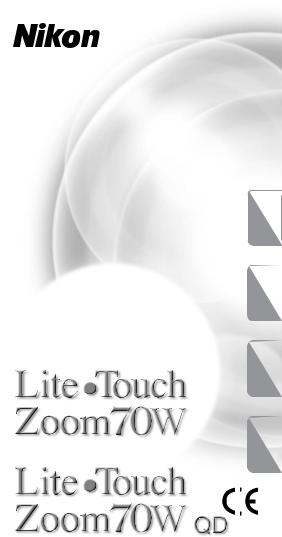
E
G
Instruction Manual (Pages 2-41) Bedienungsanleitung (Seiten 42-81) Manuel d’ulilisation (Pages 82-121)
Manual de instrucciones (Páginas 122-161)
F
S

Thank you for purchasing the Nikon Lite Touch Zoom 70W / Lite Touch Zoom 70W QD camera.
Be sure to read this manual thoroughly before use, and keep it handy until you feel confident using the camera.
Your Nikon camera features:
• |
35mm compact camera with built-in 2.5X zoom lens |
|
|
from 28 to 70 mm focal length range. ( |
p. 14) |
• |
Close-up photography in Macro mode for subjects as |
|
|
near as at 0.6 to 1.0 m (2.0 to 3.3 ft.). ( |
p. 29) |
Symbols used in this manual
:Indicates items to be checked, such as requirements and restrictions.
:Indicates notes and cautions you are requested to follow.
:Indicates supplementary descriptions. : Indicates pages for reference.
Accessories
(The following item is supplied with this camera.)
Strap
Attaching the strap
Attach the strap as shown in the illustration.
2 Getting Started

Table of Contents
Camera parts _________________________________________ 4-7 Body ______________________________________________ 4 LCD panel __________________________________________ 6 Indications in the viewfinder ____________________________ 7
1 Preparations
Installing a battery _______________________________________ 8 Turning the camera on ____________________________________ 9 Checking the battery power ________________________________ 9 Loading the film _______________________________________ 10
2 Basic Operations
Holding the camera properly ______________________________ 12 Operating the Shutter Release button _______________________ 13 Zooming _____________________________________________ 14 Shooting _____________________________________________ 15 Rewinding the film _____________________________________ 17 Removing the film ______________________________________ 17
3 Advanced Operations
When the main subject is not in the center of the picture _____________ 18 Difficult-to-focus subjects ________________________________ 19 Flash photography ______________________________________ 20 Procedure for Flash Photography __________________________ 21 To automatically fire the flash _____________________________ 22 To cancel flash operation _________________________________ 23 To fire the flash intentionally ______________________________ 24 To photograph a person in a night view ______________________ 25 To reduce the "Red-eye" effect _____________________________ 26 Shooting a distant view or landscape through a window _____________ 28 Using the self-timer _____________________________________ 28 Close-up photography ___________________________________ 29 Imprinting the date/time on pictures
(Lite Touch Zoom 70W QD only) _______________________ 30
4 Additional Information
Correcting the date and time
(Lite Touch Zoom 70W QD only) _______________________ 31 Replacing the battery for date
(Lite Touch Zoom 70W QD only) _______________________ 32 Troubleshooting _______________________________________ 34 Camera care tips _______________________________________ 36 Specifications _________________________________________ 37 For safe handling of the camera ___________________________ 39
Getting Started |
3 |

Camera parts (Body)
Macro button
( |
p. 29) |
Red-eye Reduciton |
|
lamp ( |
p. 26, 27) |
Self-Timer lamp |
|
( |
p. 28) |
Viewfinder |
|
window |
|
( |
p. 7) |
Autofocus |
|
window |
|
Auto Exposure |
|
metering window |
|
|
Lens |
Autofocus window |
|
Slide cover |
|
(power switch) |
|
( |
p. 9) |
Flash ( |
pp. 20-27) |
|
|
LCD panel ( |
p. 6) |
|
|
button |
|
|
|
Red-eye Reduction |
|
||
( |
pp. 26, 27) |
|
|
Self-Timer ( |
p. 28) |
|
|
button |
|
|
|
Flash mode ( |
pp. 20-25) |
||
Infinity Focus mode ( |
p. 28) |
||
|
|
|
|
|
|
|
|
|
|
|
|
|
|
|
|
|
|
|
|
|
|
|
|
|
|
|
|
|
|
|
|
|
|
|
|
|
|
|
|
Battery chamber lid |
|||
|
|
|
|
|
|
|
( |
|
p. 8) |
|
|
|
|
|
|
|
|
Release button |
|||
|
|
|
|
|
|
Shutter |
||||
|
|
|
|
|
|
|||||
|
|
|
|
|
|
|
|
|
|
|
|
|
|
|
( |
p. 13) |
|||||
|
|
|
|
|
Zoom lever( |
|
p. 14) |
|||
|
|
|
|
|||||||
|
|
|
|
|
|
|
||||
|
|
|
|
|
(Mid |
-roll Rewind) button |
||||
|
|
|
|
|
||||||
|
|
( |
|
|
p. |
17) |
|
|
||
4 Getting Started

Red LED
( |
p. 7) |
Viewfinder  eyepiece
eyepiece
Camera back lock release lever
( |
p. 10) |
|
|
|
Tripod socket |
|
|
|
|
||
|
MODE button* |
||
|
(for selecting data to be |
||
|
imprinted or corrected) |
||
|
( |
pp. 30, 31) |
|
Date panel*
( |
pp. 30, 31) |
Film cartridge confirmation
window ( |
p. 32) |
Strap slot ( |
p. 2) |
ADJUST button* (for correcting data)
( |
p. 31) |
SEL button*
(for selecting the position of data to be corrected)
( |
p. 31) |
* Lite Touch Zoom 70W QD only
Getting Started |
5 |
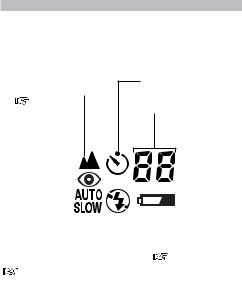
LCD panel
Self-Timer indicator Infinity Focus Mode indicator ( p. 28)
p. 28)
( p. 28)
Frame counter ( p. 11)
p. 11)
|
|
|
|
|
|
|
|
|
|
|
|
|
|
|
|
|
|
|
|
|
|
|
|
|
|
|
|
|
|
|
|
|
|
|
|
|
|
|
|
|
|
|
|
|
|
|
|
|
|
|
|
|
|
|
|
|
|
|
|
|
Low battery power indicator |
|||
|
|
|
|
|
|
|
( |
p. 9) |
||||
Red-eye Reduction indicator |
||||||||||||
|
|
|
|
|
||||||||
( |
pp. 26, 27) |
|
|
|
|
|
||||||
|
|
|
|
|
|
|
|
|
|
|
|
|
Flash Mode indicator ( pp. 20-25)
pp. 20-25)
The illustrations are fully labeled for your reference.
6 Getting Started

Indications in the viewfinder
1
3
2
1Parallax compensation marks
For shooting in Macro mode at a distance of approx. 0.6 m (2.0 ft.).
2Autofocus frame marks |
p. 15) |
Center the main subject to be in focus within this frame.
3Red LED
Momentarily lights: Focus is achieved.
When you press the Shutter Release button, the shutter is released, but the flash does not fire.
Lights up: |
Focus is achieved and the flash is |
|
ready to fire. |
|
When you press the Shutter |
|
Release button, the flash fires. |
Blinks: |
The flash is being charged. |
|
The Shutter Release button is |
|
disabled. |
Quick blinks: |
The flash dose not fire. |
|
If the popped-up flash unit is |
|
inadvertently pressed down, the |
|
LED quickly blinks as a warning. |
Does not light: |
The camera-to-subject distance is |
|
too short. |
|
Move further way than approx. |
|
0.9 m (3.0 ft.) with the wide-angle |
|
setting or 1.2 m (3.9 ft.) with the |
|
telephoto setting. |
Getting Started |
7 |

Installing a battery
 Battery type
Battery type
Use one CR2 3V lithium battery in this camera.
1. Open the battery chamber lid.
Open the battery chamber lid to the direction indicated by the arrow in the illustration.
2. Install a new battery.
Observe the correct polarities and insert the battery in the direction shown in the illustration above.
3. Close the battery chamber lid.
Firmly press the battery chamber lid until it clicks shut.
8 Preparations
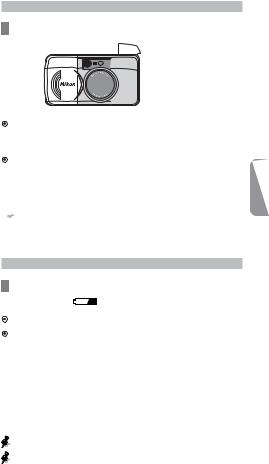
Turning the camera on
Open the slide cover.
Once you open the cover in the direction of the arrow, the camera is turned on, the built-in flash pops up, and the lens protrudes.
If the camera is not operated for more than 3 minutes, the lens automatically retracts to the  (wide-angle) position.
(wide-angle) position.
 Slide the cover until it clicks.
Slide the cover until it clicks.
 To prevent battery drain, close the slide cover (the camera is turned off) and press down the flash unit when the camera is not in use.
To prevent battery drain, close the slide cover (the camera is turned off) and press down the flash unit when the camera is not in use.
Checking the battery power
Check for the Low Battery Power indicator ( ) on the LCD panel.
If battery power is sufficient, “ ” is not indicated.
” is not indicated.
If “ ” is blinking, or all the indicators on the LCD panel do not appear, the battery is exhausted. Replace it with a new one.
” is blinking, or all the indicators on the LCD panel do not appear, the battery is exhausted. Replace it with a new one.
Always check the battery condition before shooting.
It is recommended to carry spare batteries with you. The batteries may be difficult to obtain in some areas.
Preparations 9

Loading the film
Tips on 35mm film
Number of frames
DX mark |
DX code |
|
|
DX-coded 35mm |
|
film |
Film cartridge |
Film speed
Use DX-coded 35mm film with this camera.
For DX-coded film, film speed is automatically set. Film speeds valid for automatic setting are ISO100 and 400. (When using ISO200 film or non-DX film, the film speed is automatically set to ISO100.)
When loading/unloading film, be sure not to open the camera back cover into direct sunlight.
Film recommended
It is recommended to use ISO400 film, which provides good results in flash photography, and reasonable protection against camera shake.
1. Open the camera back.
Slide the camera back lock release lever in the direction of the arrow (1) to open the camera back (2).
2. Insert a film cartridge.
10 Preparations
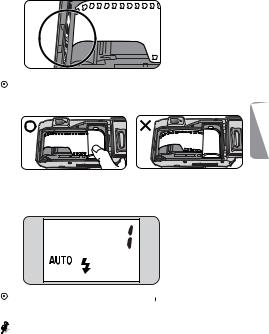
3. Pull the film leader out to the red index mark.
Hold the film cartridge and ensure film is properly positioned with no slack.
4. Close the camera back, and check that the film has been correctly loaded.
When the film has been properly set, “ ” is displayed on the frame counter when the camera is turned on.
” is displayed on the frame counter when the camera is turned on.
If the letter “
 ” blinks on the frame counter, the film is not properly loaded. Open the camera back again and reload film.
” blinks on the frame counter, the film is not properly loaded. Open the camera back again and reload film.
Preparations 11

Holding the camera properly
Hold the camera firmly.
<When holding the camera horizontally>
Prop your elbows against your body and hold the camera with both hands.
<When holding the camera vertically>
Make sure that the flash is on top as shown.
Do not block the lens, autofocus window, or flash with your fingers, hair, or the camera strap.
Be careful not to press down on the flash unit when it is in the popped up position.
Take some trial shots
Before taking important pictures, it is strongly recommended to take a few trial shots first to familiarize yourself with the camera and all of its features.
Nikon cannot be held responsible for malfunctions caused by using the Lite Touch Zoom 70W / Lite Touch Zoom 70W QD in ways not specified in this manual.
12 Basic Operations

Operating the Shutter Release button
1. Lightly press the button and confirm the red LED lights up.
When you press the button lightly, the focus and exposure are achieved, and the red LED lights up.
The focus is locked (Focus lock  p. 18) while the Shutter Release button is depressed lightly.
p. 18) while the Shutter Release button is depressed lightly.
2. Fully depress the Shutter Release button to take the picture.
 Pressing the Shutter Release button abruptly in one stroke may result in camera shake. Be sure to slowly press the Shutter Release button.
Pressing the Shutter Release button abruptly in one stroke may result in camera shake. Be sure to slowly press the Shutter Release button.
Basic Operations 13
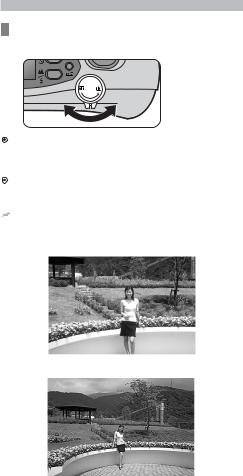
Zooming
Press the Zoom lever to compose the picture.
Press the lever to the direction of  for telephoto (70mm) photography or to the direction of
for telephoto (70mm) photography or to the direction of  for wide-angle (28mm) photography.
for wide-angle (28mm) photography.
Remove your finger from the lever when the desired image size is obtained.
 If the camera is not operated for more than 3 minutes, the lens automatically retracts to the
If the camera is not operated for more than 3 minutes, the lens automatically retracts to the  (wide-angle) position.
(wide-angle) position.
 Example of a telephoto photograph
Example of a telephoto photograph
 Example of a wide-angle photograph
Example of a wide-angle photograph
14 Basic Operations
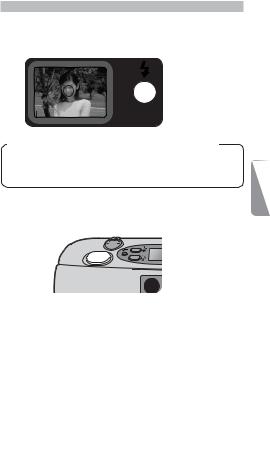
Shooting
1. Center the autofocus frame mark on the main subject.
If the main subject is outside the autofocus frame:
If the main subject is outside the autofocus frame, use the focus lock to achieve focus. ( p. 18)
p. 18)
2. Lightly press the Shutter Release button.
 The relationships between the red LED indications and the camera functions are shown in the table below:
The relationships between the red LED indications and the camera functions are shown in the table below:
|
Focusing |
Flash |
Shutter (Shooting) |
||
Momentarily |
Complete |
Does not |
Enabled |
|
|
lights |
fire |
|
|||
|
|
|
|||
Steadily |
Complete |
Fires |
Enabled |
|
|
lights |
|
||||
|
|
|
|
||
Slowly |
— |
Being |
Locked*1 ( |
p. 16) |
|
blinks |
charged |
||||
|
|
|
|||
Quickly |
— |
Does not |
Enabled*2 ( |
p. 16) |
|
blinks |
fire |
||||
|
|
|
|||
Does not
Impossible — Locked*3 ( p. 16)
light
(continued on the next page)
Basic Operations 15

Shooting (continued)
*1 While the red LED is blinking with the Shutter Release button pressed lightly, the flash is being charged, and the shutter cannot be released. Lightly press the Shutter Release button again, and release the shutter after the red LED stops blinking and stays lit.
*2 If the popped-up flash unit is inadvertently pressed down, the red LED quickly blinks as a warning. In this case, the shutter is released, but the flash does not fire.
*3 If the subject is closer than approx. 0.9 m (3.0 ft.) in the wide-angle setting or approx. 1.2 m (3.9 ft.) in the telephoto setting, the red LED does not light even when you press the Shutter Release button, and the shutter cannot be released. Move away from the subject until the red LED lights up. Note that the Shutter Release button may still work even if the camera-to-subject distance is extremely short, i.e., out of the control range of the camera.
3. Slowly press the Shutter Release button all the way.
If the subject is dark in Auto Flash mode, the flash fires automatically.
Pressing the Shutter Release button abruptly in one stroke may result in camera shake.
When closing the cover, first slide it slightly in to start the lens retraction. When the lens is completely retracted, slowly close the cover. The flash unit stays in the popped-up position even when you close the cover and the camera is turned off. Press the flash unit down to return it to its original position.
 When not in use, close the slide cover to save battery power.
When not in use, close the slide cover to save battery power.
16 Basic Operations

Rewinding the film
Film rewinds automatically.
At the end of the film roll, the film rewinding starts automatically.
While the film is rewinding, the number on the frame counter decreases one by one. When rewinding is complete, “ ” blinks, then stops blinking and remains lit.
” blinks, then stops blinking and remains lit.
If rewinding stops midway through the roll because of a dead battery, it resumes automatically as soon as the battery is replaced.
 Do not open the camera back until the letter “
Do not open the camera back until the letter “ ” starts blinking.
” starts blinking.
To rewind the film at mid-roll
Press the  (mid-roll rewind) button using the stud on the end of the strap lug or the point of a ball-point pen.
(mid-roll rewind) button using the stud on the end of the strap lug or the point of a ball-point pen.
Once rewinding starts, there is no need to keep the button pressed.
Removing the film
1. Make sure rewind is complete by checking the letter “ ” indication.
2. Open the camera back and remove the film.
Basic Operations 17
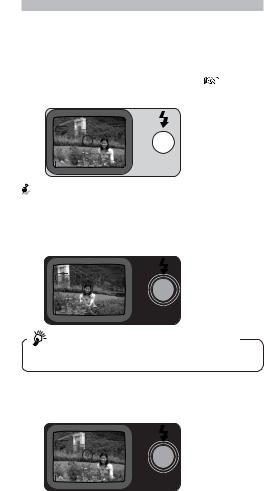
When the main subject is not in the center of the picture
Focus lock photography
When the subject to be focused is outside the autofocus frame in the center of the picture, use focus lock, which enables you to change the picture composition while locking the focus. Also use focus lock for difficult-to-
focus subjects described on the next page ( |
p.19). |
1 Compose the picture.
 If the shutter is released in a condition like that in the above example where the main subject is out of focus.
If the shutter is released in a condition like that in the above example where the main subject is out of focus.
2. Center the autofocus frame mark on the main subject,then lightly press the Shutter Release button.
Do not change the camera-to-subject distance
While you lightly press the Shutter Release button, the focus is locked. Do not change the camera-to-subject distance.
3. While depressing the Shutter Release button lightly, recompose the picture and depress the Shutter Release button all the way.
18 Advanced Operations

Difficult-to-focus subjects
The following subjects may be difficult to focus. Use the focus lock ( p. 18) to focus on another
subject equidistant from the camera, then compose the picture to shoot.
 Subjects too small to fully cover the autofocus frame mark.
Subjects too small to fully cover the autofocus frame mark.
 Subjects behind glass.
Subjects behind glass.
reflection.
 surfaces, such as shiny cars or water.
surfaces, such as shiny cars or water.
 Subjects without solid content (i.e., candle flame, fireworks, etc.).
Subjects without solid content (i.e., candle flame, fireworks, etc.).
 Secondary subjects are closer to the camera than the main subject.
Secondary subjects are closer to the camera than the main subject.
Advanced Operations 19

Flash photography
Selecting the flash mode
You can select any of five flash modes by pressing the  button.
button.
 : Auto Flash(
: Auto Flash( p. 22)
p. 22)
The flash automatically fires when there is not enough light.
 : Infinity Focus(
: Infinity Focus( p. 28)
p. 28)
For shooting a distant scene or landscape more sharply.
 : Flash Cancel(
: Flash Cancel( p. 23)
p. 23)
To cancel flash operation in lighting conditions where normally the flash would automatically fire.
 : Anytime Flash(
: Anytime Flash( p. 24)
p. 24)
To fire the flash intentionally regardless of the available light.
 : Slow-Sync Flash(
: Slow-Sync Flash( p. 25)
p. 25)
To brighten both the subject and the background at dusk or in night scenes.
While the red LED is blinking with the Shutter Release button pressed lightly, the flash is being charged, and the shutter cannot be released. Lightly press the Shutter Release button again, and release the shutter after the red LED stops blinking and stays lit.
20 Advanced Operations

Procedure for Flash Photography
1. Press the  button to select the Flash mode.
button to select the Flash mode.
 Since slow shutter speeds are usually selected in
Since slow shutter speeds are usually selected in  (Flash Cancel) and
(Flash Cancel) and 

 (Slow Sync Flash) modes, use a tripod to prevent camera shake.
(Slow Sync Flash) modes, use a tripod to prevent camera shake.
2. Compose the picture, then lightly press the Shutter Release button.
3. Checkshoot. that the red LED lights up, then
Flash shooting range
The reference distance values are shown below. With ISO100 film speed:
 (wide-angle) setting: approx. 0.9 to 3.3 m (3.0 to 10.9 ft.)
(wide-angle) setting: approx. 0.9 to 3.3 m (3.0 to 10.9 ft.)
 (telephoto) setting: approx. 1.2 to 1.9 m (4.0 to 6.2 ft.) With ISO400 film speed:
(telephoto) setting: approx. 1.2 to 1.9 m (4.0 to 6.2 ft.) With ISO400 film speed:
 (wide-angle) setting: approx. 0.9 to 6.6 m (3.0 to 21.8 ft.)
(wide-angle) setting: approx. 0.9 to 6.6 m (3.0 to 21.8 ft.)  (telephoto) setting: approx. 1.2 to 3.8 m (4.0 to 12.5 ft.)
(telephoto) setting: approx. 1.2 to 3.8 m (4.0 to 12.5 ft.)
 Do NOT press against the flash unit. If extra force is applied to the flash unit, the red LED quickly blinks as a warning. (In this case, the shutter is released, but the flash does not fire.)
Do NOT press against the flash unit. If extra force is applied to the flash unit, the red LED quickly blinks as a warning. (In this case, the shutter is released, but the flash does not fire.)
Advanced Operations 21
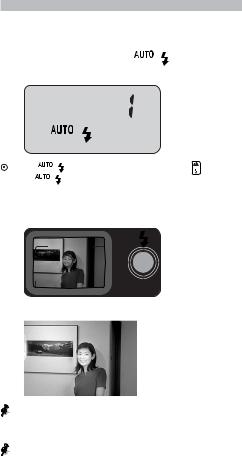
To automatically fire the flash
Auto Flash mode
The flash automatically fires when the subject is dark.
1. Make sure that the |
” mark |
||
appears on the LCD panel. |
|
||
|
|
|
|
|
|
|
|
If the “ |
” mark does not appear, press the |
button |
until “ |
” appears on the LCD panel. |
|
2. Checkshoot. that the red LED lights up, then
Example
If the subject is sufficiently illuminated, the flash does not fire. In this case, the red LED momentarily lights to notify you of this when you lightly press the Shutter Release button.
When the red LED is blinking with the Shutter Release button pressed lightly, the flash is being charged, and the shutter cannot be released. Lightly press the Shutter Release button again, and release the shutter after the red LED steadily lights up.
22 Advanced Operations

To cancel flash operation
Flash Cancel mode
Use this mode in places, such as museums, where flash photography is prohibited.
1. Use a tripod or place the camera on a stable flat surface.
Use a tripod for Flash Cancel mode
Since slow shutter speeds are usually selected in this mode, use a tripod to prevent camera shake.
2. Press the  button until “ ” appears on the LCD panel.
button until “ ” appears on the LCD panel.
3. Make sure that the red LED momentarily lights, then shoot.
Example
Advanced Operations 23
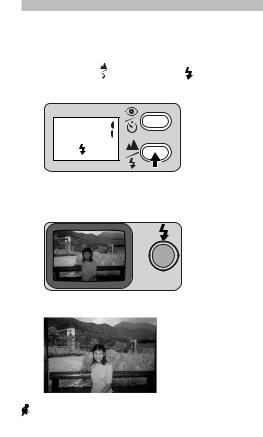
To fire the flash intentionally
Anytime Flash mode
Use this mode to intentionally fire the flash without regard to light conditions.
1. Press the  button until “ ” appears on the LCD panel.
button until “ ” appears on the LCD panel.
2. Make sure that the red LED lights up, then shoot.
Example
When the red LED is blinking with the Shutter Release button pressed lightly, the flash is being charged, and the shutter cannot be released. Lightly press the Shutter Release button again, and release the shutter after the red LED steadily lights up.
24 Advanced Operations
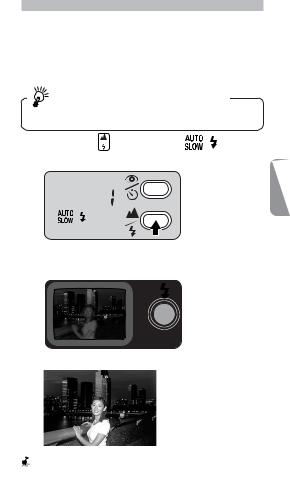
To photograph a person in a night view
Slow Sync Flash mode
Use this mode to brighten both the subject and the background in a night view or at dusk.
1. Use a tripod or place the camera on a stable flat surface.
Use a tripod for Slow Sync Flash mode
Since slow shutter speeds are usually selected in this mode, use a tripod to prevent camera shake.
2. Press the button until “ |
” |
||
appears on the LCD panel. |
|
||
|
|
|
|
|
|
|
|
3. Make sure that the red LED lights up, then shoot.
Example
 When the red LED is blinking with the Shutter Release button pressed lightly, the flash is being charged, and the shutter cannot be released. Lightly press the Shutter Release button again, and release the shutter after the red LED steadily lights up.
When the red LED is blinking with the Shutter Release button pressed lightly, the flash is being charged, and the shutter cannot be released. Lightly press the Shutter Release button again, and release the shutter after the red LED steadily lights up.
Advanced Operations 25

To reduce the "Red-eye" effect
Red-eye Reduction mode
In flash photography, the subject’s eyes may sometimes appear bright red. To reduce this “red-eye” effect, use this mode.
Press the button until “ |
” appears |
||
1. on the LCD panel. |
|
||
|
|
|
|
Each time you press the  button, the indicator changes in the order shown below:
button, the indicator changes in the order shown below:
 No indicator
No indicator 




No indicator : Red-eye Reduction mode canceled
To cancel Red-eye Reduction mode. : Red-eye Reduction mode
To reduce the “Red-eye” effect.
About Red-eye Reduction mode
This mode is not recommended when shooting fast-moving subjects.
: Self-Timer ( p. 28) mode
p. 28) mode
For self-timer operation.
Note that Red-eye Reduction is automatically set when the self-timer is used.
26 Advanced Operations

2. Compose the picture, then lightly press the Shutter Release button.
3. Check that the red LED lights up, then shoot.
Both camera and subject be still
The Red-eye Reduction lamp lights up for approx. a second before the flash fires. Be careful not to move the camera or let the subject move until the flash fires.
While the red LED is blinking with the Shutter Release button pressed lightly, the flash is being charged, and the shutter cannot be released. Lightly press the Shutter Release button again, and release the shutter after the red LED stops blinking and stays lit.
Red-eye Reduction mode is not automatically canceled by turning the power off. To cancel the Red-eye Reduction mode, press the  button until “
button until “ ” disappears from the LCD panel.
” disappears from the LCD panel.
Advanced Operations 27

Shooting a distant view or landscape through a window
Infinity Focus mode
This mode is good for shooting a distant view more sharply, or a landscape through a window.
1. Press the button until “ |
” appears on |
the LCD panel. |
|
2. Check that the red LED momentarily lights, then shoot.
 Flash is automatically canceled in this mode.
Flash is automatically canceled in this mode.
Using the self-timer
Use the self-timer when you wish to include yourself in the picture.
1. Use a tripod or place the camera on a stable flat surface.
2. Press the button until “ |
” appears on |
the LCD panel. |
|
3. Compose the picture, and press the Shutter Release button.
Focus and exposure are achieved by pressing the Shutter Release button lightly.
When the Shutter Release button is pressed all the way, the Red-eye reduction/Self-timer lamp blinks and lights up for 10 seconds in total before the shutter is released.
After the shot, Self-Timer mode is automatically canceled.
Self-Timer mode is automatically canceled also when the slide cover is closed.
28 Advanced Operations
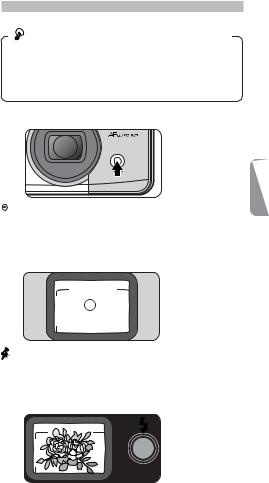
Close-up photography
 Minimum camera-to-subject distance is apporox.
Minimum camera-to-subject distance is apporox.
0.6 m (2.0 ft.) in Telephoto shooting
If you wish to shoot a subject such as a flower as large as possible, you can get as close to the subject as apporox. 0.6 m (2.0 ft.). The camera-to-subject distance range in Macro mode is approx. 0.6 to 1.0 m (2.0 to 3.3 ft.). Note that, however, this mode is not intended to duplicate drawings.
1. Press the Macro button.
2 |
|
8- |
|
|
7 |
0
m
m
|
ro |
c |
|
Ma |
|
When you press the Macro button, the lens is automatically set to the Macro position, and Anytime Flash mode is selected.
2. Compose the picture while pressing the Macro button, then lightly press the Shutter Release button.
When the camera-to subject distance is approx. 0.6m (2.0 ft.), the area marked with in the illustration is included in the picture.
3. Check that the red LED lights up, then shoot.
Advanced Operations 29

Imprinting the date/time on pictures
(Lite Touch Zoom 70W QD only)
Select the date/time indicator by pressing the MODE button.
The year is indicated by the lower two digits (“ ” for 2000 and “  ” for 2001) and printed, and the time is in the 24-hour cycle. The example in the illustration shows March. 1, 2000.
” for 2001) and printed, and the time is in the 24-hour cycle. The example in the illustration shows March. 1, 2000.
The letter “M” appears to label the month indication, but it is not imprinted on pictures.
Each time you press the MODE button, the indicator changes in the order shown below:
Year/Month/Day Day/Hour/Minute NO printing
Day/Month/Year Month/Day/Year
If “ ” is displayed on the LCD panel, the date/time of the shot will be imprinted on the picture.
Set to “




 ” (No printing) if you prefer the date/time not to be imprinted.
” (No printing) if you prefer the date/time not to be imprinted.
Imprint position of date/time
Imprint position |
The imprint positions is shown in the illustration.
 The imprinted date/time may be difficult to recognize if the imprint position or the subject is:
The imprinted date/time may be difficult to recognize if the imprint position or the subject is:
•White or bright.
•Orange or yellow.
30 AdvancedditionalOperationsInformation
